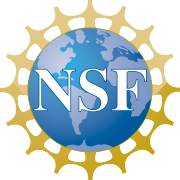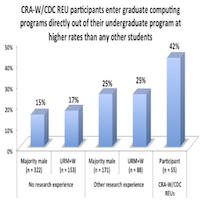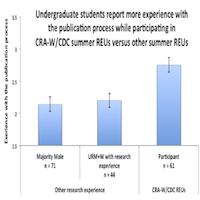Highlights of the CISE Fiscal Year 2014 Budget Request
 On April 10th, the President delivered the Fiscal Year 2014 Budget Request to Congress. The Administration is requesting a total of nearly $7.6 billion dollars for NSF, which is an increase of $593 million, or almost 8.4 percent, over the FY 2012 NSF Enacted level. The Request also includes an increase of $85 million, or 9.8 percent, over the FY 2012 Enacted Level for the Computer and Information Science and Engineering (CISE) directorate, for a total of $950.25 million. For more information on the NSF FY 2014 budget, see:http://www.nsf.gov/about/budget/fy2014/index.jsp.
On April 10th, the President delivered the Fiscal Year 2014 Budget Request to Congress. The Administration is requesting a total of nearly $7.6 billion dollars for NSF, which is an increase of $593 million, or almost 8.4 percent, over the FY 2012 NSF Enacted level. The Request also includes an increase of $85 million, or 9.8 percent, over the FY 2012 Enacted Level for the Computer and Information Science and Engineering (CISE) directorate, for a total of $950.25 million. For more information on the NSF FY 2014 budget, see:http://www.nsf.gov/about/budget/fy2014/index.jsp.
For more than six decades, NSF has had a profound impact on our Nation’s discovery and innovation ecosystem by funding transformative research that has pushed forward the frontiers of knowledge. As the only Federal agency dedicated to the support of basic research and education in all fields of science and engineering, NSF enables discoveries across a broad spectrum of scientific inquiry. In its mission to promote progress in computer and information science and engineering research, education and infrastructure, CISE will continue to cast a wide net, letting the best ideas surface. Requested funding for each of CISE’s four divisions – Advanced Cyberinfrastructure (ACI), Computing and Communication Foundations (CCF), Computer and Network Systems (CNS), and Information and Intelligent Systems (IIS) will support a broad range of ambitious, long-term research in computer, communication, and information science and engineering.
The CISE FY 2014 Request is shaped by investments in its core basic research, education, and infrastructure programs as well as investments in a cross-cutting portfolio that aligns closely with national priorities and societal challenges. In particular, I want to emphasize four specific areas: 1) expansions of CISE foundational research; 2) cross-cutting areas of exploration; 3) advanced cyberinfrastructure; and 4) education and workforce development.
Expansions of CISE Foundational Research: I wish to take this opportunity to reaffirm CISE’s strong commitment to its core programs in all areas of computer and information science and engineering. Specifically, I want to focus on two highly complementary foundational research programs launched last year — Core Techniques and Technologies for Advancing Big Data Science and Engineering (BIGDATA) and eXploiting Parallelism and Scalability (XPS). In partnership with all other NSF directorates, CISE is leading the BIGDATA program in its second year. The goal is to address fundamental big data challenges, whose solutions may have wide applicability across a broad range of science and engineering domains. In XPS, the goal is to support groundbreaking research leading to a new era of parallel computing. XPS seeks research re-evaluating, and possibly re-designing, the traditional computer hardware and software stack for today’s heterogeneous parallel and distributed systems and exploring new holistic approaches to parallelism and scalability.
Cross-cutting Investments in which CISE is the Lead: CISE leads a number of programs that span multiple NSF directorates to catalyze foundational research. Secure and Trustworthy Cyberspace (SaTC) is a partnership with the Directorates for Education and Human Resources (EHR), Engineering (ENG), Mathematical and Physical Sciences (MPS), and Social, Behavioral, and Economic Sciences (SBE); it seeks to protect the Nation’s critical infrastructure, including the Internet, from a wide range of threats that challenge its security and reliability. The Cyber-Physical Systems (CPS) program (with ENG) aims to deeply integrate computation, communication, and control into physical systems and to engineer complex “smart” cyberphysical systems. All NSF directorates are participating in Cyber-enabled Sustainability Science and Engineering (CyberSEES), which is a partnership with the Semiconductor Research Corporation (SRC); it aims to advance interdisciplinary research in which the science and engineering of sustainability are enabled by new advances in computing, and where computational innovation is grounded in the context of sustainability problems. Through programs such as the Innovation Corps (I-Corps), CISE will continue to foster public-private partnerships to accelerate transfer of knowledge from lab to practice to benefit society.
CISE is also actively engaging in several interagency initiatives and programs. For example, the National Robotics Initiative (NRI) is a partnership with three other agencies — NASA, NIH, and USDA – as well as three other NSF directorates — EHR, ENG, and SBE. The goal is to develop the next generation of collaborative robots that promise to enhance personal safety, health, and productivity. Smart and Connected Health is a newly formed partnership between NSF (including CISE, ENG, and SBE) and six institutes at the National Institutes of Health (NIH); it aims to accelerate the development and use of innovative approaches that would support the much-needed transformation of healthcare from reactive and hospital-centered to preventive, proactive, evidence-based and person-centered, with a focus on well-being rather than disease. CISE is also leveraging and building upon its investments in computational neuroscience as part of the recently announced, multiagency BRAIN (Brain Research through Advancing Innovative Neurotechnologies) Initiative, with NSF efforts led by BIO and SBE.
Advanced Cyberinfrastructure: Cyberinfrastructure has increasingly become a critical component of the R&D ecosystem. Realizing the enormous potential of cyberinfrastructure to advance discovery across all disciplines requires a long-term, bold, sustainable, and comprehensive approach. In FY 2014, CISE, in partnership with all NSF research directorates, will increase its investments in the Cyberinfrastructure Framework for 21st Century Science and Engineering (CIF21) programs. The goal is to develop and deploy comprehensive, integrated, sustainable, and secure cyberinfrastructure (CI), accelerating a new era in scientific discovery and engineering innovation, thereby transforming our ability to effectively address and solve the many complex problems facing science and society. NSF-wide investments include Data Infrastructure Building Blocks (DIBBs), BIGDATA, Software Infrastructure for Sustained Innovation (SI2), and Computational and Data-Enabled Science and Engineering (CDS&E).
With the launch of Stampede and Blue Waters, NSF continues to make significant investments in advanced cyberinfrastructure as well as in research and education networks, including the Campus Cyberinfrastructure – Network Infrastructure and Engineering (CC-NIE) Program and Global Environment for Network Innovations (GENI), a virtual laboratory for exploring future internets at scale.
Education and Workforce Development: In FY 2014, it is estimated that CISE will support approximately 20,800 people across the spectrum from undergraduate and graduate students to postdoctoral fellows and senior researchers. CISE reaffirms its commitment to education and workforce programs, including Faculty Early Career and Graduate Research Fellowships (CAREER and GRF), which support early-career researchers and contribute to the development of future generations of scientists and engineers. In collaboration with several other Directorates, including EHR and SBE, CISE will grow its investments on research in cyberlearning and online education, promising to integrate advances in technology with advances in what is known about how people learn. This is an important area of inter-disciplinary exploration with enormous potential to transform formal and informal education.
CISE continues its focus on STEM-C Partnerships (formerly, the Computing Education for the 21st Century (CE21) program) in order to increase the pool of students and teachers who develop and practice computational and data competencies in a variety of contexts and to prepare more students to pursue degrees in computing, computation, and data-intensive fields of study.
Computer and information science and engineering is a robust field of inquiry that has impacted nearly every part of today’s society. Our investments in cross-cutting activities along with foundational CISE research and education programs will keep our community at the leading edge of discovery and innovation. I invite you to work with the National Science Foundation to ensure that our Nation remains at the forefront of advances in science and engineering research, education, and infrastructure.
——————————————————————————–
Farnam Jahanian is the Assistant Director for Computer and Information Science and Engineering at the National Science Foundation.









